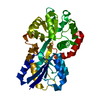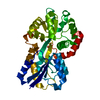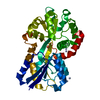+ Open data
Open data
- Basic information
Basic information
| Entry | Database: PDB / ID: 8c4y | |||||||||
|---|---|---|---|---|---|---|---|---|---|---|
| Title | SFX structure of FutA bound to Fe(III) | |||||||||
 Components Components | Putative iron ABC transporter, substrate binding protein | |||||||||
 Keywords Keywords | METAL BINDING PROTEIN / Periplasmic iron-binding protein / metal ion binding / iron homeostasis | |||||||||
| Function / homology | Bacterial extracellular solute-binding protein / Ferric binding protein / iron ion transport / outer membrane-bounded periplasmic space / metal ion binding / : / Putative iron ABC transporter, substrate binding protein Function and homology information Function and homology information | |||||||||
| Biological species |  Prochlorococcus marinus subsp. pastoris str. CCMP1986 (bacteria) Prochlorococcus marinus subsp. pastoris str. CCMP1986 (bacteria) | |||||||||
| Method |  X-RAY DIFFRACTION / X-RAY DIFFRACTION /  FREE ELECTRON LASER / FREE ELECTRON LASER /  MOLECULAR REPLACEMENT / Resolution: 1.6 Å MOLECULAR REPLACEMENT / Resolution: 1.6 Å | |||||||||
 Authors Authors | Bolton, R. / Tews, I. | |||||||||
| Funding support |  United Kingdom, 2items United Kingdom, 2items
| |||||||||
 Citation Citation |  Journal: Proc.Natl.Acad.Sci.USA / Year: 2024 Journal: Proc.Natl.Acad.Sci.USA / Year: 2024Title: A redox switch allows binding of Fe(II) and Fe(III) ions in the cyanobacterial iron-binding protein FutA from Prochlorococcus. Authors: Bolton, R. / Machelett, M.M. / Stubbs, J. / Axford, D. / Caramello, N. / Catapano, L. / Maly, M. / Rodrigues, M.J. / Cordery, C. / Tizzard, G.J. / MacMillan, F. / Engilberge, S. / von ...Authors: Bolton, R. / Machelett, M.M. / Stubbs, J. / Axford, D. / Caramello, N. / Catapano, L. / Maly, M. / Rodrigues, M.J. / Cordery, C. / Tizzard, G.J. / MacMillan, F. / Engilberge, S. / von Stetten, D. / Tosha, T. / Sugimoto, H. / Worrall, J.A.R. / Webb, J.S. / Zubkov, M. / Coles, S. / Mathieu, E. / Steiner, R.A. / Murshudov, G. / Schrader, T.E. / Orville, A.M. / Royant, A. / Evans, G. / Hough, M.A. / Owen, R.L. / Tews, I. #1:  Journal: Biorxiv / Year: 2023 Journal: Biorxiv / Year: 2023Title: A redox switch allows binding of Fe(II) and Fe(III) ions in the cyanobacterial iron binding protein FutA from Prochlorococcus; Authors: Bolton, R. / Machelett, M. / Stubbs, J. / Axford, D. / Caramello, N. / Catapano, L. / Maly, M. / Rodrigues, M. / Cordery, C. / Tizzard, G. / MacMillan, F. / Engilberge, S. / Stetten, D. / ...Authors: Bolton, R. / Machelett, M. / Stubbs, J. / Axford, D. / Caramello, N. / Catapano, L. / Maly, M. / Rodrigues, M. / Cordery, C. / Tizzard, G. / MacMillan, F. / Engilberge, S. / Stetten, D. / Tosha, T. / Sugimoto, H. / Worrall, J. / Webb, J. / Zubkov, M. / Coles, S. / Mathieu, E. / Steiner, R. / Murshudov, G. / Schrader, T. / Orville, A. / Royant, A. / Evans, G. / Hough, M. / Owen, R. / Tews, I. | |||||||||
| History |
|
- Structure visualization
Structure visualization
| Structure viewer | Molecule:  Molmil Molmil Jmol/JSmol Jmol/JSmol |
|---|
- Downloads & links
Downloads & links
- Download
Download
| PDBx/mmCIF format |  8c4y.cif.gz 8c4y.cif.gz | 81.7 KB | Display |  PDBx/mmCIF format PDBx/mmCIF format |
|---|---|---|---|---|
| PDB format |  pdb8c4y.ent.gz pdb8c4y.ent.gz | Display |  PDB format PDB format | |
| PDBx/mmJSON format |  8c4y.json.gz 8c4y.json.gz | Tree view |  PDBx/mmJSON format PDBx/mmJSON format | |
| Others |  Other downloads Other downloads |
-Validation report
| Summary document |  8c4y_validation.pdf.gz 8c4y_validation.pdf.gz | 913.1 KB | Display |  wwPDB validaton report wwPDB validaton report |
|---|---|---|---|---|
| Full document |  8c4y_full_validation.pdf.gz 8c4y_full_validation.pdf.gz | 914.4 KB | Display | |
| Data in XML |  8c4y_validation.xml.gz 8c4y_validation.xml.gz | 13.3 KB | Display | |
| Data in CIF |  8c4y_validation.cif.gz 8c4y_validation.cif.gz | 18.3 KB | Display | |
| Arichive directory |  https://data.pdbj.org/pub/pdb/validation_reports/c4/8c4y https://data.pdbj.org/pub/pdb/validation_reports/c4/8c4y ftp://data.pdbj.org/pub/pdb/validation_reports/c4/8c4y ftp://data.pdbj.org/pub/pdb/validation_reports/c4/8c4y | HTTPS FTP |
-Related structure data
| Related structure data |  8oeiC  8oemC  8oggC  8rk1C C: citing same article ( |
|---|---|
| Similar structure data | Similarity search - Function & homology  F&H Search F&H Search |
- Links
Links
- Assembly
Assembly
| Deposited unit | 
| ||||||||
|---|---|---|---|---|---|---|---|---|---|
| 1 |
| ||||||||
| Unit cell |
|
- Components
Components
| #1: Protein | Mass: 35219.246 Da / Num. of mol.: 1 Source method: isolated from a genetically manipulated source Source: (gene. exp.)  Prochlorococcus marinus subsp. pastoris str. CCMP1986 (bacteria) Prochlorococcus marinus subsp. pastoris str. CCMP1986 (bacteria)Gene: futA,sfuA, idiA, PMM1164 / Plasmid: pET- 24b(+) / Production host:  |
|---|---|
| #2: Chemical | ChemComp-FE / |
| #3: Water | ChemComp-HOH / |
| Has ligand of interest | Y |
| Has protein modification | Y |
-Experimental details
-Experiment
| Experiment | Method:  X-RAY DIFFRACTION / Number of used crystals: 1 X-RAY DIFFRACTION / Number of used crystals: 1 |
|---|
- Sample preparation
Sample preparation
| Crystal | Density Matthews: 2.06 Å3/Da / Density % sol: 40.27 % |
|---|---|
| Crystal grow | Temperature: 294 K / Method: batch mode Details: Purified protein, diluted crystal seeds, and crystallisation buffer were mixed at a 1:1.5:1.5 ratio. Crystallisation buffer was 25% PEG 3350, 200 mM sodium thiocyanate. Crystal seed stock ...Details: Purified protein, diluted crystal seeds, and crystallisation buffer were mixed at a 1:1.5:1.5 ratio. Crystallisation buffer was 25% PEG 3350, 200 mM sodium thiocyanate. Crystal seed stock was diluted 1:20 in 25% PEG 3350. |
-Data collection
| Diffraction | Mean temperature: 298 K / Serial crystal experiment: Y |
|---|---|
| Diffraction source | Source:  FREE ELECTRON LASER / Site: FREE ELECTRON LASER / Site:  SACLA SACLA  / Beamline: BL2 / Wavelength: 1.127 Å / Beamline: BL2 / Wavelength: 1.127 Å |
| Detector | Type: MPCCD / Detector: CCD / Date: Jun 26, 2019 |
| Radiation | Protocol: SINGLE WAVELENGTH / Monochromatic (M) / Laue (L): M / Scattering type: x-ray |
| Radiation wavelength | Wavelength: 1.127 Å / Relative weight: 1 |
| Reflection | Resolution: 1.6→30.1 Å / Num. obs: 37266 / % possible obs: 99.8 % / Redundancy: 618.7 % / Biso Wilson estimate: 12.09 Å2 / CC1/2: 0.99 / R split: 0.053 / Net I/σ(I): 12.1 |
| Reflection shell | Resolution: 1.6→1.628 Å / Redundancy: 274.5 % / Mean I/σ(I) obs: 4.6 / Num. unique obs: 1877 / CC1/2: 0.91 / R split: 0.089 / % possible all: 100 |
| Serial crystallography measurement | Pulse duration: 10 fsec. / XFEL pulse repetition rate: 30 Hz |
| Serial crystallography sample delivery | Method: fixed target |
| Serial crystallography sample delivery fixed target | Description: Silicon nitride chip / Details: 25600 apertures / Sample dehydration prevention: Sealed with a Mylar film |
- Processing
Processing
| Software |
| |||||||||||||||||||||||||||||||||||||||||||||||||||||||||||||||||||||||||||||||||||||||||||||||||||||||||||||||||||||||||||||||||||||||||||||||||||||||||||
|---|---|---|---|---|---|---|---|---|---|---|---|---|---|---|---|---|---|---|---|---|---|---|---|---|---|---|---|---|---|---|---|---|---|---|---|---|---|---|---|---|---|---|---|---|---|---|---|---|---|---|---|---|---|---|---|---|---|---|---|---|---|---|---|---|---|---|---|---|---|---|---|---|---|---|---|---|---|---|---|---|---|---|---|---|---|---|---|---|---|---|---|---|---|---|---|---|---|---|---|---|---|---|---|---|---|---|---|---|---|---|---|---|---|---|---|---|---|---|---|---|---|---|---|---|---|---|---|---|---|---|---|---|---|---|---|---|---|---|---|---|---|---|---|---|---|---|---|---|---|---|---|---|---|---|---|---|
| Refinement | Method to determine structure:  MOLECULAR REPLACEMENT / Resolution: 1.6→30.096 Å / Cor.coef. Fo:Fc: 0.946 / Cor.coef. Fo:Fc free: 0.941 / SU B: 1.831 / SU ML: 0.063 / Cross valid method: FREE R-VALUE / ESU R: 0.099 / ESU R Free: 0.091 MOLECULAR REPLACEMENT / Resolution: 1.6→30.096 Å / Cor.coef. Fo:Fc: 0.946 / Cor.coef. Fo:Fc free: 0.941 / SU B: 1.831 / SU ML: 0.063 / Cross valid method: FREE R-VALUE / ESU R: 0.099 / ESU R Free: 0.091 Details: Hydrogens have been added in their riding positions
| |||||||||||||||||||||||||||||||||||||||||||||||||||||||||||||||||||||||||||||||||||||||||||||||||||||||||||||||||||||||||||||||||||||||||||||||||||||||||||
| Solvent computation | Ion probe radii: 0.8 Å / Shrinkage radii: 0.8 Å / VDW probe radii: 1.2 Å / Solvent model: MASK BULK SOLVENT | |||||||||||||||||||||||||||||||||||||||||||||||||||||||||||||||||||||||||||||||||||||||||||||||||||||||||||||||||||||||||||||||||||||||||||||||||||||||||||
| Displacement parameters | Biso mean: 17.084 Å2
| |||||||||||||||||||||||||||||||||||||||||||||||||||||||||||||||||||||||||||||||||||||||||||||||||||||||||||||||||||||||||||||||||||||||||||||||||||||||||||
| Refinement step | Cycle: LAST / Resolution: 1.6→30.096 Å
| |||||||||||||||||||||||||||||||||||||||||||||||||||||||||||||||||||||||||||||||||||||||||||||||||||||||||||||||||||||||||||||||||||||||||||||||||||||||||||
| Refine LS restraints |
| |||||||||||||||||||||||||||||||||||||||||||||||||||||||||||||||||||||||||||||||||||||||||||||||||||||||||||||||||||||||||||||||||||||||||||||||||||||||||||
| LS refinement shell |
|
 Movie
Movie Controller
Controller



 PDBj
PDBj


